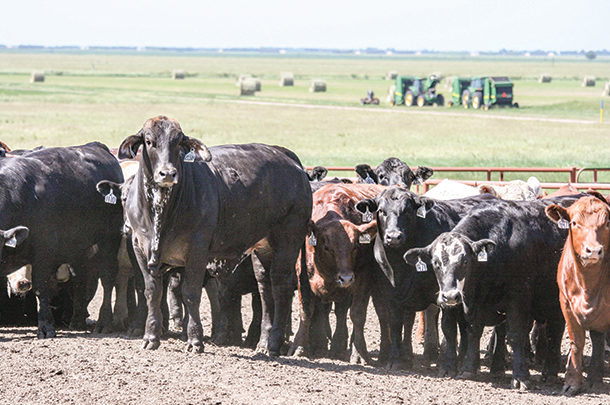The National Cattlemen’s Beef Association (NCBA) Producer Education Cattlemen’s Webinar Series released an installment discussing health issues in mid- to late-fed cattle. Three experts spoke on a wide range of current issues cattle experience in the feeding period, being costly for animal welfare and the bottom line.
Fortunately, there is plenty of research in the works to help cattlemen and feeders work together to reduce death loss and improve quality of life for the animals in their care.
Brisket disease
Significant time, research and genetic evaluations have been spent on feedlot heart disease, brisket disease or bovine pulmonary hypertension. This issue is problematic for animals raised in regions of the country with high altitudes. In mountainous country, the problem is well-known, but it is by no means exclusive to the area.
Dr. Milt Thomas of Colorado State University explained, “We have what we call the Great Plains, and in that region, there is still a pretty high-elevation plain that’s a big component of the beef industry. It has really moderate altitude with a 3,000- to 5,000-foot elevation fed on those systems. [This is where] we observe what we call FHD or feedlot heart disease.”
Cattle with high pulmonary arterial pressure, or PAP, struggle with oxygen deficiency, and it can be further amplified by factors such as altitude, lung disease, exercise, heart disease, anemia, blood flow restriction (fescue toxicity), tissue metabolism and obesity. In certain regions, about 10,000 replacement animals are PAP-tested annually, with some operations doing it as early as weaning.
“PAP usually runs in the range of 40 to 50 millimeters of mercury, and over 50 is high risk,” said Thomas. “In general, when we sample cattle in the mountains, about 50 percent of those will have a low PAP, 40 percent will [be] moderate, and about 10 percent will have that really high PAP.”
PAP is heritably moderate, being an indicator trait for cardiopulmonary remodeling and tolerance of hypoxia. Being polygenic, a lot of things can influence PAP. These are amplified in fed cattle.
Thomas spoke of some research he was involved in that examined how metabolism and inflammation predict the cardiopulmonary outcomes in fattening cattle. The animals were PAP-tested three times prior to slaughter, and many of them increased their PAP score as they approached slaughter rate. As opposed to pulmonary hypertension seen in high elevation (sometimes called high mountain disease), which is failure of the right ventricle, cattle who suffered heart issues on the feedlot appeared to involve left ventricle failure. There is much more to be learned about PAP in feeding cattle and how it can be prevented and treated.
Mid-feeding period morbidity
Morbidity concerns late in life for high-performing cattle was the topic Myriah Johnson, NCBA senior director of sustainability research, covered. Genetic selection for high-performing cattle – for traits such as high average daily gains (ADG), improved feed efficiency and carcass quality – has led to more anecdotal observations of bovine respiratory disease (BRD) in the feeding period. Typically, BRD strikes in 45 to 100 days on feed.
“If we look at historic feedlot death loss, and this is USDA data, we see that in 1999 our death loss was about 1.3 percent, which is OK,” Johnson said. “If we go down the road 12 years to 2011, and even this is a little bit dated now, we’ve had a 23 percent death loss increase, with death loss being 1.6 percent. I can tell you, even in these past nine years or so, that number has not reversed.”
The issue with BRD at this stage is that it often strikes quickly and subclinically, sometimes referred to as midday morbidity because animals appear fine early in the day only to be dead after lunchtime.
A study she highlighted was one she worked on with Dr. Miles Theurer of Veterinary Research and Consulting Services. It looked at 194 commercial heifers and found that 28.3% of them tested positive for BRD at the first pull from the feedlot, coming from 10 different ranches.
Both Johnson and Theurer believe a solution to this starts at the ranch level.
“At this point, we do not have definitive recommendations for efforts to reduce mid-feeding period morbidity,” says Theurer. “Vaccination, pre-conditioning and good animal husbandry have been proven and are still recommended to improve health outcomes; however, additional collaboration throughout the entire supply chain is needed to identify the most effective and necessary practices to improve health outcomes.”
Fatigued cattle syndrome and shipping issues
The ultimate end of the beef cycle reflects nearly two full years of labor and expenses, and it’s very easy to cause some costly damage just prior to slaughter. Dr. Dan Thomson of Iowa State University highlighted fatigued cattle syndrome (FCS) and shipping bruises.
“We estimate that we will lose around five to 10 dollars per head on bruising when we have this at the plant,” he said. “We looked at over 8,000 carcasses to look at the bruising, and what we found is that 53 percent of cattle have at least one bruise.”
The most prevalent place of bruising is down the dorsal area; the biggest culprit was animals hitting the ramp to the top deck of semi-trailers as they jumped off in the unloading process. Thomson referenced one of his studies where they adjusted the clearance by 3 inches for unloading. The rate of bruising dropped from 53% to 5% by that simple change.
Fatigued cattle syndrome (FCS) is a condition in which excessive lactic acid builds up in the muscles as the result of fat cattle being moved too quickly and aggressively from feedlot to truck to packing plant. It’s a similar mechanism to what happens in dark cutters. At the packing plant, research has found these animals also have high levels of creatine kinase from muscle damage.
“Feedlots that do not handle cattle with care in the summer, or any other season, have more cattle condemned due to FCS than those that work to prevent it,” Thomson said. “With heavier outweights due to a backlog of cattle, this summer it will be even more important to handle our finished cattle with care.”
In some of his research, Thomson oversaw cattle who were walked at a half-mile versus those who were trotted for the same difference. Cattle who were walked not only had normal creatine kinase and lactic acid levels; they also had fewer muscle tremors at the packing plant. This issue is very manageable but requires high levels of employee training and patience.
Thomson says the biggest incentive to increase handling care is to remember the pay for quality carcasses. It takes around 200 days to finish an animal, and that work can greatly be reduced or entirely undone in 20 minutes of movement. This was a similar theme throughout the presentations.
The feeding period to slaughter is a pivotal time for animals, as a loss at this late stage could mean the loss of hundreds or even thousands of dollars and hours of hard work. Research, coupled with proper management, are important focuses in this area of the beef sector and will continue to be so as meat availability and quality becomes more and more important.









